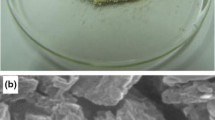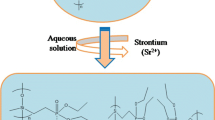Abstract
Wholly heterocycles-based polyamide-sulfide (PAS) containing pyridine and thiazole rings with thioether linkage was synthesized and used as a novel adsorbent for lead ion removal from water. The polymer adsorbent was fully characterized via FTIR, NMR and scanning electron microscopy (SEM). The thermal properties of the synthesized polyamide were also studied by thermogravimetric analysis and the outcome showed that the polymer has a good to moderate thermal stability. The SEM was used to investigate the morphology of the wholly heterocycles-based polyamide and the outcomes displayed a porous and globular-like morphology, which guarantee effective metal adsorption. Pb(II) ion removal capacity of the synthesized polymer was studied by varying the contact time and the adsorbent concentration. The maximum removal of Pb(II) was obtained as 99%. Equilibrium behavior and kinetic of the adsorption were also investigated using prevalent isotherm and kinetic models. The adsorption capacity was obtained to be around 714 mg g−1. The Langmuir isotherm and the pseudo-second order kinetic model suggested superior agreement with the equilibrium and kinetic adsorption data, respectively. Generally, the results of this research demonstrated that the synthesized polymer is a super-adsorbent for heavy metal removal from water.










Similar content being viewed by others
References
Narwade VN, Khairnar RS, Kokol V (2018) In Situ synthesized hydroxyapatite—cellulose nanofibrils as biosorbents for heavy metal ions removal. J Polym Environ 26:2130
Mohsen-Nia M, Montazeri P, Modarress H (2007) Removal of Cu2+ and Ni2+ from wastewater with a chelating agent and reverse osmosis processes. Desalination 217:276
Ismail AA, Mohamed R, Ibrahim I, Kini G, Koopman B (2010) Synthesis, optimization and characterization of zeolite A and its ion-exchange properties. Colloid Surf A 366:80
Meunier N, Drogui P, Montané C, Hausler R, Mercier G, Blais J-F (2006) Comparison between electrocoagulation and chemical precipitation for metals removal from acidic soil leachate. J Hazard Mater 137:581
Deng Y, Englehardt JD (2007) Electrochemical oxidation for landfill leachate treatment. Waste Manag 27:380
Salehi E, Madaeni SS, Samiei Raad S, Shirazi Manesh AA, Vatanpour V (2011) Thermodynamically comparison of Na+ and Ca2+ adsorption onto PVD and NF45 membranes. Desalination 281:312
Hassanpour S, Taghizadeh M, Yamini Y (2018) Magnetic Cr(VI) ion imprinted polymer for the fast selective adsorption of Cr(VI) from aqueous solution. J Polym Environ 26:101
Salehi E, Madaeni SS, Vatanpour V (2012) Thermodynamic investigation and mathematical modeling of ion-imprinted membrane adsorption. J Membr Sci 389:334
Ozbas Z, Demir S, Kasgoz H (2018) Adsorption studies of PVA based thermosensitive polymers in heavy metal removal. J Polym Environ 26:2096
Feng D, Bai B, Wang H, Suo Y (2018) Novel fabrication of PAA/PVA/yeast superabsorbent with interpenetrating polymer network for pH-dependent selective adsorption of dyes. J Polym Environ 26:567
Yuan X, Meng Y, Zeng G, Fang Y, Shi J (2008) Evaluation of tea-derived biosurfactant on removing heavy metal ions from dilute wastewater by ion flotation. Colloid Surf A 317:256
Pan B, Pan B, Zhang W, Lv L, Zhang Q, Zheng S (2009) Development of polymeric and polymer-based hybrid adsorbents for pollutants removal from waters. Chem Eng J 151:19
Mishra SP, Singh VK, Tiwari D (1996) Radiotracer technique in adsorption study: part XIV. Efficient removal of mercury from aqueous solutions by hydrous zirconium oxide. Appl Rad Isotop 47:15
Erdem E, Karapinar N, Donat R (2004) The removal of heavy metal cations by natural zeolites. J Colloid Interface Sci 280:309
Celis R, Hermosin MC, Cornejo J (2000) Heavy metal adsorption by functionalized clays. Environ Sci Technol 34:4593
Ishibashi N, Yamamoto K, Wakisaka H, Kawahara Y (2014) Influence of the hydrothermal pre-treatments on the adsorption characteristics of activated carbons from woods. J Polym Environ 22:267
Nagarale R, Gohil G, Shahi VK (2006) Recent developments on ion-exchange membranes and electro-membrane processes. Adv Colloid Interface Sci 119:97
Wang X, Lv P, Zou H, Li Y, Li X, Liao Y (2016) Synthesis of poly(2-aminothiazole) for selective removal of Hg(II) in aqueous solutions. Ind Eng Chem Res 55:4911
Xiong C, Wang S, Zhang L, Li Y, Zhou Y, Peng J (2018) Preparation of 2-aminothiazole-functionalized poly (glycidyl methacrylate) microspheres and their excellent gold ion adsorption properties. Polymers 10:159
Zhuang H, Yang L, Xu J, Li F, Zhang Z, Lin H, Long J, Wang X (2015) Robust photocatalytic H2O2 production by octahedral Cd3(C3N3S3)2 coordination polymer under visible light. Sci Rep 5:16947
Matlock MM, Henke KR, Atwood DA, Robertson D (2001) Aqueous leaching properties and environmental implications of cadmium, lead and zinc trimercaptotriazine (TMT) compounds. Water Res 35:3649
Kirupha SD, Murugesan A, Vidhyadevi T, Baskaralingam P, Sivanesan S, Ravikumar L (2012) Novel polymeric adsorbents bearing amide, pyridyl, azomethine and thiourea binding sites for the removal of Cu(II) and Pb(II) ions from aqueous solution. Sep Sci Technol 48:254
Rezania J, Shockravi A, Ehsani M, Vatanpour V (2018) Novel polyimides based on diamine containing thiazole units with thioether linkage and pyridine as pendent group: synthesis and characterization. High Perf Polym 30:840
Javadi A, Shockravi A, Kamali M, Rafieimanesh A, Malek AM (2013) Solution processable polyamides containing thiazole units and thioether linkages with high optical transparency, high refractive index, and low birefringence. J Polym Sci A 51:3505
Salehi E, Afshar S, Zarezadeh Mehrizi M, Chehrei A, Asadi M (2018) Direct reduction of blood serum cholesterol using Thymus vulgaris L.: Preliminary biosorption study. Process Biochem 67:155
Salehi E, Gavari N, Chehrei A, Amani S, Amani N, Zaghi K (2019) Efficient separation of triglyceride from blood serum using Cinnamon as a novel biosorbent: adsorption thermodynamics, kinetics, isothermal and process optimization using response surface methodology. Process Biochem 77:122
Ahmed R, Yamin T, Ansari MS, Hasany SM (2006) Sorption behaviour of lead (II) ions from aqueous solution onto Haro river sand. Ads Sci Technol 24:475
Jaycock MJ, Parfitt GD (1981) Chemistry of Interfaces. Ellis Horwood Ltd, Onichester
Ruthven DW (1984) Principles of adsorption and adsorption processes. Wiley, New York
Salehi E, Madaeni SS, Rajabi L, Vatanpour V, Derakhshan A, Zinadini S, Ghorabi S, Ahmadi Monfared H (2012) Novel chitosan/poly (vinyl) alcohol thin adsorptive membranes modified with amino functionalized multi-walled carbon nanotubes for Cu (II) removal from water: preparation, characterization, adsorption kinetics and thermodynamics. Sep Purif Technol 89:309
Salehi E, Madaeni SS, Rajabi L, Derakhshan A, Daraei S, Vatanpour V (2013) Static and dynamic adsorption of copper ions on chitosan/polyvinyl alcohol thin adsorptive membranes: combined effect of polyethylene glycol and aminated multi-walled carbon nanotubes. Chem Eng J 215–216:791
Tianwei T, Xiaojing H, Weixia D (2001) Adsorption behaviour of metal ions on imprinted chitosan resin. J Chem Technol Biotechnol 76:191
Chien SH, Clayton WR (1980) Application of Elovich equation to the kinetics of phosphate release and sorption in soils. Soil Sci Soc America J 44:265
Liu Y, Liu Z, Gao J, Dai J, Han J, Wang Y, Xie J, Yan Y (2011) Selective adsorption behavior of Pb(II) by mesoporous silica SBA-15-supported Pb(II)-imprinted polymer based on surface molecularly imprinting technique. J Hazard Mater 186:197
Huang K, Li B, Zhou F, Mei S, Zhou Y, Jing T (2016) Selective solid-phase extraction of lead ions in water samples using three-dimensional ion-imprinted polymers. Anal Chem 88:6820
Elsherbiny AS, El-Hefnawy ME, Gemeay AH (2018) Adsorption efficiency of polyaspartate-montmorillonite composite towards the removal of Pb(II) and Cd(II) from aqueous solution. J Polym Environ 26:411
Koushkbaghi S, Zakialamdari A, Pishnamazi M, Ramandi HF, Aliabadi M, Irani M (2018) Aminated-Fe3O4 nanoparticles filled chitosan/PVA/PES dual layers nanofibrous membrane for the removal of Cr(VI) and Pb(II) ions from aqueous solutions in adsorption and membrane processes. Chem Eng J 337:169
Facchi DP, Cazetta AL, Canesin EA, Almeida VC, Bonafé EG, Kipper MJ, Martins AF (2018) New magnetic chitosan/alginate/Fe3O4@SiO2 hydrogel composites applied for removal of Pb(II) ions from aqueous systems. Chem Eng J 337:595
Maity J, SRay K (2018) Chitosan based nano composite adsorbent—Synthesis, characterization and application for adsorption of binary mixtures of Pb(II) and Cd(II) from water. Carbohydr Polym 182:159
Moradi G, Dabirian F, Mohammadi P, Rajabi L, Babaei M, Shiri N (2018) Electrospun fumarate ferroxane/polyacrylonitrile nanocomposite nanofibers adsorbent for lead removal from aqueous solution: characterization and process optimization by response surface methodology. Chem Eng Res Design 129:182
Tabesh S, Davar F, Loghman-Estarki MR (2018) Preparation of γ-Al2O3 nanoparticles using modified sol-gel method and its use for the adsorption of lead and cadmium ions. J Alloys Compd 730:441
Zhang Z, Zhang X, Niu D, Li Y, Shi J (2017) Highly efficient and selective removal of trace lead from aqueous solutions by hollow mesoporous silica loaded with molecularly imprinted polymers. J Hazard Mater 328:160
Kong D, Qiao N, Wang N, Wang Z, Wang Q, Zhou Z, Ren Z (2018) Facile preparation of a nano-imprinted polymer on magnetite nanoparticles for the rapid separation of lead ions from aqueous solution. Phys Chem Chem Phys 20:12870
Nyairo W, Ramazan Eker Y, Chrispin K, Akin I, Bingol H, Tor A, Mokono Ongeri D (2018) Efficient adsorption of lead (II) and copper (II) from aqueous phase using oxidized multiwalled carbon nanotubes/polypyrrole composite. Sep Sci Technol 53:1498
Shahabuddin S, Tashakori C, Kamboh MA, Sotoudehnia Korrani Z, Saidur R, Rashidi Nodeh H, Bidhendi ME (2018) Kinetic and equilibrium adsorption of lead from water using magnetic metformin-substituted SBA-15. Environ Sci Water Res Technol 4:549
Acknowledgments
The authors gratefully acknowledge the financial support of Kharazmi University.
Author information
Authors and Affiliations
Corresponding author
Additional information
Publisher's Note
Springer Nature remains neutral with regard to jurisdictional claims in published maps and institutional affiliations.
Rights and permissions
About this article
Cite this article
Rezania, H., Vatanpour, V., Salehi, E. et al. Wholly Heterocycles-Based Polyamide–Sulfide Containing Pyridine and Thiazole Rings: A Super-Adsorbent Polymer for Lead Removal. J Polym Environ 27, 1790–1800 (2019). https://doi.org/10.1007/s10924-019-01473-4
Published:
Issue Date:
DOI: https://doi.org/10.1007/s10924-019-01473-4




